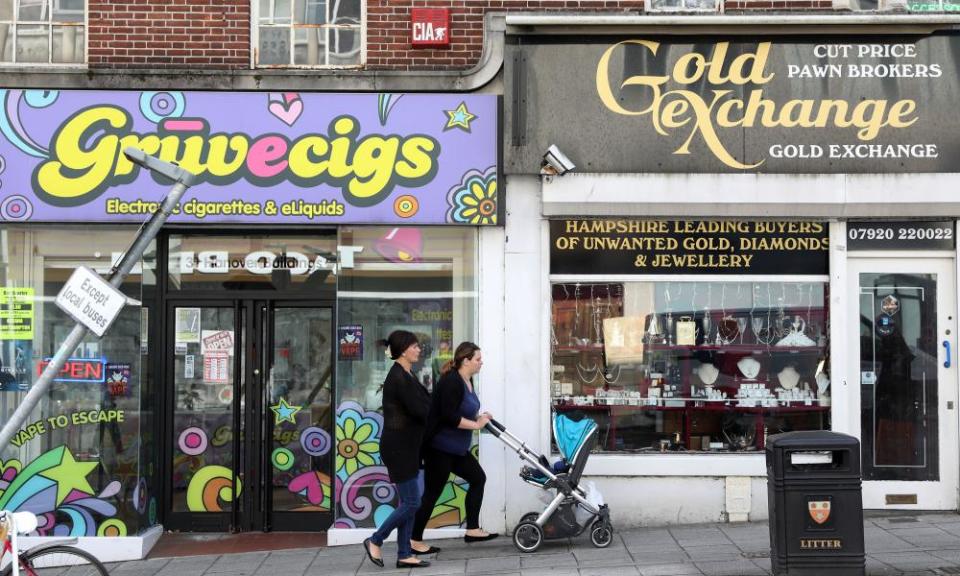Our high streets don’t need new shops – they need new ideas | Suzanne Moore

I wonder if anyone has mapped the rise of the vaping shop on to the leave vote. Wandering down another semi-abandoned high street, the only new businesses appear to be purveyors of vaping and all its works. A sweet caramelly smell is in the air. Then, of course, another sunbed shop. Eyebrow threaders, waxers and nail bars. Why not treat yourself for under a tenner when money is short? A small treat. Everything may be hard to manage, but your nails can be perfect miniature paintings. Women, who often work in service industries, can get 15 minutes with someone at their service. Why not?
In between these bursts of hope and the charity shops and the bookies there is so much empty retail space. There are big shops, sometimes former chain stores, with windows covered in bird shit and repossession notices, some boarded up. Some have been empty for years. Some appear suddenly. They are blank spaces waiting to be filled. But do we really think they will be?
The beauty of retail – the endless opportunity – has shut up shop. For so long, shopping as a leisure pursuit, as a goal in itself, as a fundamental answer to every life crisis, has been central. Cheer yourself up at the shops. Shop till you drop. When the going gets tough, the tough go shopping. All of that belongs to a long-gone decade of boom.
Of course, people still want nice things, but the idea that shopping is, by itself, magically regenerative, has taken a hit, both personally and in terms of how we relate to public space. Something has to give. New research has found that 4,534 stores opened in the UK last year, but 5,430 closed down. Big fashion chains and banks disappeared – banks to the internet, chains often to out-of-town retail parks. There has been a consumer slowdown and a structural change, as well as a rise in prices.
The result of all this is visible in so many small towns – and big cities. There are more coffee shops than you can throw a stick at in my local high street, where you can buy actual sticks in a florist for £18, as well as stupidly priced baby clothes. A little further away, there is a pawnbroker and a parade of pound shops. Again, though, there are many empty spaces, because business rates and rents are so high. Even the most dedicated gentrifier cannot seem to free up empty places on which absentee landlords sit. We can laugh at the artisanal, knitted, vegan cupcake enterprises and wish that Woolworths were still open, but at least this is a life of some sort. The death of the high street, the sense of abandonment, neglect and loss, is about more than having a variety of shopping choices; it is about having a centre where there will be some human interaction.
When theorists talk breezily about the coming automation, it is hard to imagine robots making spaghetti or cutting toenails, so we fail to see that it is already here. From self-service checkouts to ATMs, small exchanges and kindnesses have disappeared from many lives. Pack your own bag. Speak to a pre-recorded message. Press star to pay your bill. It is easy enough to deride as racist and negative the fantasy of a Brexitty nostalgia, where everyone knew everyone else, but it is not reducible to this alone. It contains within it a fantasy of the sociability of a shared space.
If the buying and selling of things we need and want provided an identity – a day out, a cheap thrill, a wandering, a chance to see other people – and that has gone, the idea of regeneration through retail alone is surely limited. There have been many valiant efforts – and who doesn’t love a pop-up shop or a restaurant or art gallery? – but locals are often bemused by their lack of content. They may well be another sign of gentrification via displacement, but dead, empty spaces make ghost towns. Of course, leases have to be freed up for creatives, restaurateurs, artists and entrepreneurs: the kind of people we say will build our future. But it is a stop gap.
When regeneration is centralised, it is often dislocating. Hackney Walk, in east London, a post-riots project that created 450,000sq ft of retail space and then handed it over to luxury brand outlets including Burberry, Anya Hindmarch and Aquascutum, is a place where there is so little relationship between buyers and locals that it feels like two fingers up. But even if this had been turned into a bunch of quirky little shops, retail on its own cannot provide wages or homes.
These spaces need to be turned into places to live affordably or places that generate social interaction. Councils should negotiate the opening up of these leases instead of blocking social innovators. There are a few places, such as Brighton, Bristol and Chesterfield, where repair cafes have been set up. People learn how to fix everything from toasters to knitwear. In Edinburgh, there is one such workshop where electrical repair skills are taught alongside darning.
This is better than boarding up lives. Shopping will not save our souls or our towns – we need to live in the spaces where we once used to pay.

 Yahoo News
Yahoo News 